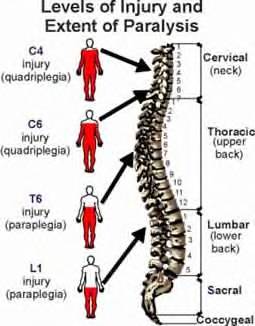Paralysis is loss of muscle function for one or more muscles. Paralysis can be accompanied by a loss of feeling (sensory loss) in the affected area if there is sensory damage as well as motor. A study conducted by the Christopher & Dana Reeve Foundation, suggests that about 1 in 50 people have been diagnosed with paralysis.
Clasification of paralysis:
- Monoplegia,.... in which only one limb hand or leg is affected
- Diplegia,.... in which both the limbs are affected
- Paraplegia,.... in which both the trunk and the legs are affected
- Hemiplegia,.... in which only one side of the body is affected
- Quadriplegia,.... in which the trunk and all the four limbs are affected

Paralysis could be one of the most terrible conditions that a human body can be afflicted with.
A paralyzed person loses the capacity of voluntary movement in some part of the body, like the hands,
legs or torso; and hence becomes an invalid. The most terrible aspect of paralysis is when the person
has to become overtly dependent on someone else to accomplish the most routine of tasks.
Minor paralyses can be treated and the person can become healthy
again (in this case it means that the person can move all his or her body parts in a normal manner again) . But treatment of major paralysis, such as loss of movement in the hands, legs or the whole torso,
can be a very long and arduous process. it might require a lot of cooperation from the patient as well
as the family members. Some people afflicted with paralysis remained paralyzed all through their lives,
as tissue and muscle wasting can cause irreparable damage to the body.
Stroke is a medical emergency which results when the blood supply to a part of the brain is cut off or greatly reduced. An ischemic stroke is the most common type of stroke, occurring about 80 - 85 % of the time, and is due to a blood vessel in the brain getting blocked because of cholesterol deposits called atherosclerosis, or because of blood clots called emboli. A hemorrhagic stroke, resulting from a ruptured blood vessel in the brain, while not so commonly seen, is definitely more serious.
Depending upon what part of the brain and how much of the brain tissue is affected, stroke can cause symptoms like weakness or paralysis of the limbs, paralysis of the muscles of the face, difficulty in speaking, coordination problems, dizziness, vision problems, sudden headache, and loss of consciousness. This can result in monoplegia (paralysis of one limb), hemiplegia (paralysis of upper and lower limb in one side of the body), and paraplegia (paralysis of lower limbs).
Stroke is known in Ayurveda as "Pakshaghaat". Ayurveda has mentioned facial paralysis as a separate disease entity called "Ardita". Acute stroke is a full-fledged medical emergency where immediate hospitalization and specialized medical care of the patient can be life saving and can minimize permanent disability. After a patient is discharged from hospital, it is imperative to start Ayurvedic treatment at the earliest possible, to get maximum benefit. |













